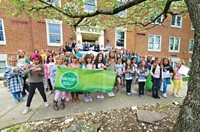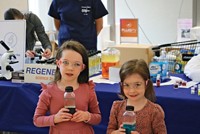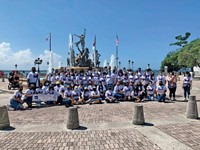Advertisement
Grab your lab coat. Let's get started
Welcome!
Welcome!
Create an account below to get 6 C&EN articles per month, receive newsletters and more - all free.
It seems this is your first time logging in online. Please enter the following information to continue.
As an ACS member you automatically get access to this site. All we need is few more details to create your reading experience.
Not you? Sign in with a different account.
Not you? Sign in with a different account.
ERROR 1
ERROR 1
ERROR 2
ERROR 2
ERROR 2
ERROR 2
ERROR 2
Password and Confirm password must match.
If you have an ACS member number, please enter it here so we can link this account to your membership. (optional)
ERROR 2
ACS values your privacy. By submitting your information, you are gaining access to C&EN and subscribing to our weekly newsletter. We use the information you provide to make your reading experience better, and we will never sell your data to third party members.
Outreach
Local sections host National Chemistry Week 2023 events
Volunteers engaged the public in hands-on activities and demonstrations during a weeklong outreach campaign
by Nina Notman, special to C&EN
December 17, 2023
| A version of this story appeared in
Volume 101, Issue 41
From Oct. 15 to 21, American Chemical Society members from 130 local sections, two international chemical sciences chapters, and a number of student chapters celebrated National Chemistry Week 2023 (NCW 2023) by educating the public about chemistry’s role in health and medicine.
This year’s theme was “The Healing Power of Chemistry.” Thousands of people participated in outreach events in K–12 schools, universities, malls, museums, libraries, parks, and other public spaces.
“National Chemistry Week this year was the perfect opportunity to emphasize the connection between chemistry and good health all over the world,” Lori Stepan, chair of the ACS Committee on Community Activities, states in an email. “This is especially important because these young people exploring chemistry today may become doctors, nurses, and researchers in the future.”
Free ACS resources for NCW 2023 included the magazine Celebrating Chemistry. During this year’s NCW events, ACS distributed 92,500 print copies in English and 12,500 in Spanish. ACS also sponsored an illustrated poem contest for K–12 students (see box on page 40).
The following are highlights of the NCW 2023 events:
TheCalifornia Section organized a booth at the Solano Avenue Stroll in Berkeley and Albany, where visitors made ultraviolet-detecting bead bracelets and explored the effect of breath on a red cabbage pH indicator. The section also attended two school science festivals.
The California State University, Stanislaus, Student Chapter, also called the Warriors Chemistry Club, organized a seminar about the materials involved in dentistry.
The Carolina-Piedmont Section hosted a hands-on event for 15 attendees aged 8–12 at the Fort Mill Public Library. Visitors explored how milk of magnesia reduces stomach acid, how X-rays produce images, and how fluoride protects teeth.
The Central Arkansas Local Section ran a walk-by table at the Creep ’N Crawl 5K run at Two Rivers Park in Little Rock. Visitors investigated how milk of magnesia reduces stomach acid and made slime and marbled paper.
The Central Ohio Valley Section held a hands-on chemistry event at the Heritage Farm’s Fall Festival. Children explored how milk of magnesia reduces stomach acid and used vinegar–baking soda bottle rockets to launch corks.

The Central Wisconsin Local Section conducted a make-and-take lotion activity for 120 attendees at the University of Wisconsin–Stevens Point Family Day.
The Chicago Section created K–12 teacher kits with activities, materials, and videos. It also hosted a family day with 13 hands-on activity stations.
Nearly 70 volunteers from the Cincinnati Section ran hands-on chemistry demonstrations for 500 children and 200 adults in 28 public libraries.
New York’s Corning Section organized an event at Corning–Painted Post Middle School, where 16 scientists ran hands-on activities in 16 classrooms.

The East Tennessee Section hosted a number of events, including a chemistry show at the University of Tennessee’s Knoxville campus and an academic showcase at the university’s homecoming football game.
The Eastern New York Section held an event at the Colonie Center mall in Albany, where 70 volunteers ran hands-on activities. More than 230 children made blood-colored slime and learned about soap, hand sanitizer, penicillin, and neutralizing stomach acid.
Pennsylvania’s Erie Local Section coordinated a hands-on event with nine demonstrations for children at a local shopping mall.
Vermont’s Green Mountain Local Section organized an all-day event with hands-on activities and a chemistry magic show at the Echo, Leahy Center for Lake Champlain.
Events hosted by Virginia’s Hampton Roads Local Section included a science movie night at Old Dominion University’s planetarium, a Younger Chemists Committee meetup at a local brewery, and a science field trip to the Mariners’ Museum.
Illinois’s Joliet Section created a haunted lab event for local Girl Scout groups.
The Mark Twain Local Section of Illinois, Iowa, and Missouri conducted chemical demonstrations and hands-on activities at Quincy University.
The Maryland Section ran 16 hands-on programs in libraries in six counties. Participants built models of glucose and fructose, weighed sugar cube equivalents of common drinks and foods, and observed the effect of vinegar on starch digestion.
The Michigan State University Local Section hosted a Chemistry Day event with hands-on activities and demonstrations in partnership with the Impression 5 Science Center.
New York’s Mid-Hudson Section worked with local institutions and student sections to organize a Kilomole Day Breakfast, provide materials for Kids Chemistry Night at SUNY Orange, and sponsor Vassar College’s Chemistry College Bowl.

Texas’s Midland College Student Chapter, also called the Midland College Chemistry Club, held a hands-on event at a local mall, where visitors participated in experiments including using a red cabbage indicator to explore how milk of magnesia neutralizes stomach acid.
Marie Migaud of Alabama’s Mobile Local Section talked to over 200 high school and middle school students and teachers on where we find chemistry in health and health care.
Connecticut’s New Haven Section organized two hands-on science events for approximately 200 students in grades 5–8. Participants extracted DNA from strawberries and explored how milk of magnesia reduces stomach acid.
The New York Local Section and PepsiCo hosted an event with demonstrations at the New York Hall of Science.
The Nigeria International Chemical Sciences Chapter held a 3 h virtual event that included two invited talks and flash presentations from all the Nigerian student chapters.
The North Jersey Section partnered with the Liberty Science Center to run demonstrations and hands-on activities at an event attended by more than 2,000 children.

Dana M. Barry of the Northern New York Local Section helped students in grades 3–6 at the St. Catherine of Siena Academy design and create bandages using various tapes and paddings. She also distributed ACS resources to other local schools.
Approximately 80 volunteers from the Northern Oklahoma Local Section helped nearly 2,000 grade 4 and 5 students at 17 local schools explore how milk of magnesia reduces stomach acid.
The Nova Southeastern University Student Chapter hosted a week’s worth of lunchtime activities that included lectures, a nature walk in a medicinal garden, and a self-care day in which participants made sugar-and-oatmeal facial masks and scrubs.
The Pensacola Section partnered with the University of West Florida Chemistry Club to host a tie-dye T-shirt event for students.
More than 300 volunteers from the Puerto Rico Section supported San Juan’s annual Festival de Química. Approximately 15,000 attendees visited 31 outdoor activity stations, a science exposition, and two chemistry shows.

The Puget Sound Section ran four activities at a local library event that was attended by about 20 families. It also organized an event for approximately 60 students at Olympia, Washington’s Hands On Children’s Museum.
The Silicon Valley Local Section hosted 300 attendees at four hands-on events: at the Dr. Martin Luther King, Jr. Library in San Jose, California; Salinas Community Science Workshop; Ronald McDonald House in Palo Alto; and the Redwood City Public Library.
The South Florida Section organized a number of events, including two at local science museums. Participants made tea bags and explored the hydrophobic effects of barrier creams.
The Southwest Georgia Section sponsored a Science Saturday event at the Hugh C. Bailey Science Center at Valdosta State University with 20 hands-on activities and demonstrations for K–12 students.
The Saint Joseph Valley Local Section of Indiana and Michigan hosted hands-on activity booths at the Science Spooktacular community event at the St. Joseph County 4-H fairgrounds.
Florida’s Tampa Bay Section arranged a booth where visitors could explore milk of magnesia’s ability to reduce stomach acid in the Museum of Science and Industry.

The University of Arizona Chemistry Club helped host a demonstration show for students at the university.
The Upper Ohio Valley Local Section performed two chemical magic shows for local elementary school students and their families.
NCW 2024 will take place Oct. 20–26 with the theme “Picture-Perfect Chemistry.” Information on how to get involved can be found at www.acs.org/ncw.
NCW 2023 National Illustrated Poem Contest Winners
As part of the National Chemistry Week 2023 celebrations, local sections hosted illustrated poem contests with K–12 students, who were invited to design entries around the theme “The Healing Power of Chemistry.” This year, 29 local sections submitted poems that won their local competitions to the national illustrated poem contest. The ACS Committee on Community Activities and the ACS Office of Science Outreach have announced this year’s national winners.
K–2nd grade
First place: Luke K., Princeton Section

Second place: Aarjav J., Southwest Georgia Section

3rd–5th grade
First place: Rhea U., Eastern New York Section

Second place: Jose T., Indiana Local Section

6th–8th grade
First place: Shreyas K., Silicon Valley Local Section

Second place: Kahiwaa L., Hawai’i Local Section

9th–12th grade
First place: Simran U., Eastern New York Section

Second place: Jolene C., New York Local Section, and Raima S., Philadelphia Local Section


Nina Notman is a freelance writer based in Salisbury, England.
CORRECTION:
This story was updated on Dec. 18, 2023 to correct the location of the images associated with the NCW 2023 National Illustrated Poem Contest 3-5th grade winner, Rhea U., and 9-12th grade winner, Simran U.





Join the conversation
Contact the reporter
Submit a Letter to the Editor for publication
Engage with us on Twitter